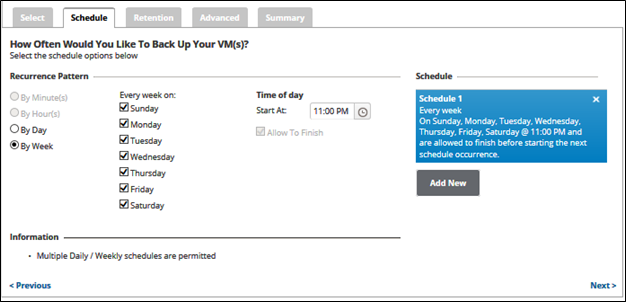To create a Hyper-V Standard backup set, perform the following steps.
- Navigate to the Computer page. See Navigating to the Computer Page for instructions.
The Computer page is displayed.

- Click the Backup tab.
The Backup Selections page is displayed.

- In the Backup Type pane, click Hyper-V Standard.
The Select page is displayed.

- Click the Backup Name to provide a new name for your backup set or accept the default.
- At the Select Storage Location section, click one of the following radio button options.
- Local Only (Local Vault must be enabled, and a local subscription is required. Data is not backed up to the cloud.)
- Online Only (An enabled Local Vault disables this option.)
- Online and Local (Local Vault must be enabled.)
The radio button you select is highlighted as shown in the example below.

In the Current Selection pane, select the available virtual machines you would like to back up.
Notes
Any VMs that already are included in other backup sets are grayed out.
A warning icon is displayed for VMs that have not been upgraded.
Clicking the arrow  at the right of the items displays more VMs.
at the right of the items displays more VMs.
Your selections are displayed in the right pane. Click the remove icon  to remove any selections or clear the VM check box.
to remove any selections or clear the VM check box.

- After making your selections, click Next.
The Schedule page is displayed.

Accept or edit the default schedule.
Notes
- The default schedule is by the week on every day starting at 11 p.m.
- Multiple daily/weekly schedules are permitted (if they do not overlap).
- The Allow to Finish check box is always selected and grayed-out.
- Your schedule is displayed in the Schedule column. Click the remove icon
 to delete the schedule.
to delete the schedule.
- After setting the schedule, click Next.
The Retention page is displayed.

Select the number of versions you wish to retain, and for how long.
The default is 4 recoverable versions of backups at the storage location that are retained for 28 days.
- Optionally, select the Enable Advanced Archiving check box.
The Advanced Archiving fields are displayed.

Make your selections, click Save Rule, and then click Next.
The Advanced page is displayed.

Requirement
You must specify a temporary folder located on a disk with sufficient space. Temporary space of 1 GB is recommended for Hyper-V backups.
- In the Temporary Folder field, accept the default, type a new path, or click the Browse button to locate the temporary folder that is used during backing up.
In the Force Full Backups section, use the arrows to specify how often full backups are performed after incremental backups.
Notes
The default full backup is every 21 incremental backups.
Taking a full VM backup periodically ensures the stability of the backup chain. Full backups take longer to run but result in shorter incremental chains and potentially shorter recovery times.
Optionally, in the Backup Mode section, select the Allow Crash-Consistent Backups check box.
Crash-consistent backups do not preserve the integrity of data for open files of transactional applications on the VM guest OS and may result in data loss.
Definitions
A crash-consistent backup captures all the virtual machine's data at the same time.
An application-consistent backup captures all the data including the data in memory and all transactions in process.
The software attempts to make an application-consistent backup. If unable, a crash-consistent backup is created.
Pre-Windows Server 2016 versions display a different backup mode option as shown below.

When enabled, the virtual machine may become unavailable during the snapshot process.
The software attempts an online backup first. If unable, an offline backup is created. The virtual machine is paused and put into a saved state while the snapshot is taken, and then the virtual machine resumes operation. VMs in a saved or a paused state can be backed up. The imported recovery VMs are in a saved state in both cases.
Tip: This mode is useful if an online backup cannot be taken. For instance, if the guest VM has dynamic disks, this mode allows guest VMs to be backed up in a non-quiesced, offline state.
- Click Next.
The Summary page is displayed.

After reviewing your selections, click the Create Backup Set button.
If you did not change the default backup set name when creating a new backup set, the following confirmation pop-up is displayed after clicking the Create Backup button.

This feature allows you to create a unique name for the backup set. If you already changed the default backup set name, the pop-up is not displayed.
Optionally, change the backup set name, and click Confirm.
- Your scheduled backup is displayed on the Backup Selections page.




 at the right of the items displays more VMs.
at the right of the items displays more VMs. to remove any selections or clear the VM check box.
to remove any selections or clear the VM check box.






 to delete the schedule.
to delete the schedule.
